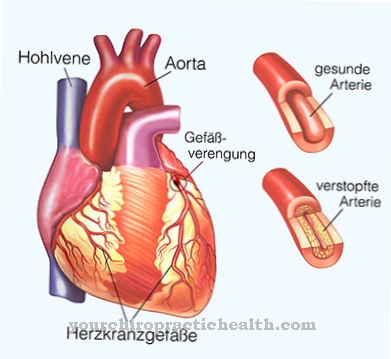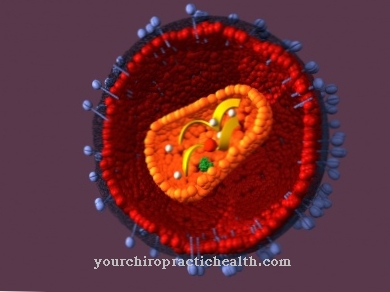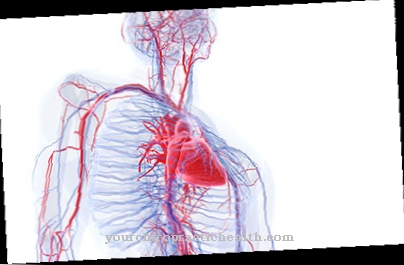A Collateral ligament tear on the knee is either the tear of the outer or inner ligament or both ligaments. As a result of the rupture (tear), the knee joint loses its stability and functionality.
What is a collateral ligament tear on the knee?

A Collateral ligament tear on the knee always affects either the outer ligament on the outside or the inner ligament on the inner side of the knee. In addition to muscles and tendons, there are also several ligaments on the knee to stabilize the knee joint.
The collateral ligaments lie on the right and left and two cruciate ligaments within the joint. The inner band runs at a slight angle from the thigh bone to the shin bone. It is relatively wide and is fused with the joint capsule that encloses the knee joint and with parts of the meniscus (cartilage disc).
The outer ligament runs from the thigh bone to the fibula. It is a little narrower and is not connected to the joint capsule. If a collateral ligament ruptures, one or both ligaments will tear and the knee joint will lose its stability. As a rule, the side ligaments tear completely, incomplete tears are rather rare.
causes
The cause of one Collateral ligament tear is usually a quick sudden twisting motion in the knee. Lateral ligament ruptures are common in sports, especially soccer and skiing. Whether the ligaments can withstand the excessive stress or tear is sometimes genetically determined.
Statistics show that the ligaments tear faster in women than in men. But the physical condition also plays a role. Those who are trained and often do sports, their ligaments are more resilient. People who exercise less or who are also overweight have a higher risk of a collateral ligament tear.
A typical movement that causes a collateral ligament to tear in ball sports is a sudden change of direction in a running movement. The foot is still on the ground in the original walking direction, the upper body is already turning in the new direction and the knee is suddenly and violently twisted. In skiing, a collateral ligament rupture often happens when the bindings do not open or when the skis go in different directions due to inexperience.
Symptoms, ailments & signs
A lateral tear on the knee is often a very painful affair, which is therefore accompanied by typical and clear symptoms. Immediately after the demolition, there is a sharp pain that persists even when at rest. Even the smallest movements and strain on the knee cause severe pain.
It is not uncommon for a visible swelling to occur in this context, which can be seen directly on the knee. In particularly severe cases, an abscess can even form, which should definitely be treated by a doctor. Affected people who decide early on for treatment can expect a significant improvement within a few weeks.
The knee can be subjected to more stress from day to day, provided that medical clearance is available. If you start too early with such a burden, you can drag out the entire healing process. A knee tendon rupture can be a tedious affair.
The more the affected knee is protected and immobilized, the faster the healing process progresses. Medical and drug treatment naturally have a positive effect on the healing process. Complete recovery cannot be guaranteed if left untreated. Under certain circumstances, serious complications can arise that lead to permanent consequential damage to the knee.
Diagnosis & course
Of the Collateral ligament tear is immediately perceived by a strong pain. Sometimes you can even hear the sound of the ribbon tearing. The affected person can no longer stand up and the knee has lost its functionality.
As the torn ligaments bleed, blood flows into the tissue around the knee joint, causing it to swell. The bruise (hematoma) creates a blue color around the knee.
Usually the doctor recognizes from the typical symptoms and the description of the accident process that a collateral ligament may be torn. Examining the knee joint is usually difficult because the patient is in severe pain and mobility is difficult to test under these circumstances.
If one of the two collateral ligaments is torn, the doctor can determine this by opening the joint to the side, which is not possible with intact ligaments. An X-ray is used to check whether bone parts are also damaged. The collateral ligament rupture can be unequivocally clarified with an MRI (magnetic resonance tomography) examination.
Complications
First and foremost, a rupture of the collateral ligament in the knee causes very severe pain. In many cases, these can spread to the neighboring regions, so that severe pain can also occur in the leg. In most cases, those affected also suffer from a bruise and severe swelling in the knee area.
Furthermore, this complaint leads to considerable restrictions in movement and thus also in the everyday life of the person concerned. Most patients can no longer walk alone and need a walking aid or are dependent on the help of other people in their everyday life. In children, the collateral ligament rupture on the knee can also lead to restrictions in development.
If the pain also occurs at night, it can lead to sleep problems and possibly irritability of the person concerned and psychological complaints. This condition is usually treated with medication and by resting the knee. There are no complications. In some cases, however, those affected are also dependent on surgical interventions.
When should you go to the doctor?
A collateral ligament tear on the knee must always be examined and treated by a doctor. As a rule, self-healing cannot occur with this disease, so that the patient is always dependent on medical treatment. Correct fusion can only be guaranteed through early and correct treatment. A doctor should be seen in the event of a collateral ligament rupture in the knee if the person concerned is suffering from very severe pain in the knee.
The pain occurs even with slight movements and loads and can also spread to other regions of the body. This usually also results in an abscess and most patients also have a bruise or severe swelling on the knee. If these symptoms occur, you should definitely consult a doctor. Consult a doctor, especially after an accident or severe injury.
The knee ligament tear can be treated by an orthopedic surgeon. In the event of severe pain or immediately after an accident, you can also go to the hospital or call an emergency doctor. In most cases, the collateral ligament tear on the knee does not limit the life expectancy of the person affected.
Treatment & Therapy
A Collateral ligament tear acute treatment in the knee should be provided immediately. The so-called PECH scheme is used for this.
1. P as in break: The current activity must be stopped immediately.
2. E for ice: the joint should be cooled immediately. In the event of a skiing accident, snow is a good option, otherwise simple, cool compresses are also useful.
3. C for Compression: A pressure bandage is applied around the knee joint to keep the swelling within limits.
4. H as in elevation: The leg should be elevated, as this allows blood and tissue fluid to drain away and does not accumulate in the knee joint.
Further therapy is based on the extent of the damage. Some collateral ligament tears can be treated conservatively (without surgery). The leg is stabilized for several weeks using a splint. If additional structures and bone parts are injured, an operation is usually unavoidable.
In a surgical procedure, the ligament parts are reassembled or completely removed and replaced by another endogenous tendon. Both after conservative and after surgical treatment of a collateral ligament tear, patients have to strengthen the muscles around the knee joint through physiotherapy exercises for several weeks.
prevention
Against a Collateral ligament tear cannot be prevented, as it usually happens through an accident. However, some sports such as ball sports or skiing have an increased risk of a collateral ligament rupture.
Aftercare
The collateral ligament tear on the knee is an injury that requires consistent follow-up care in order to optimize regeneration and achieve its best possible success. Follow-up care can be discussed with physiotherapists and rehab sports teachers, but also with fitness trainers or the treating doctor. It is important to strengthen the muscles surrounding the knee joint in order to achieve sustainable stabilization of the joint.
If the collateral ligament is torn, the adductors and abductors as well as the external and internal rotators must be strengthened. It is the muscles that spread the leg and bring it closer, as well as its inward and outward rotation. This is best possible with weight training. Weights are one way of doing this, but thera bands can also do the job. Weight training on machines has the advantage that guided movements are less prone to injury.
The training is to be carried out with the greatest possible protection of the injured structures. Overloading must be avoided. A gentle stretching of the muscles is also important. In everyday life, protection is also very important. Strong flexion with rotational movements in the knee joint must be avoided under all circumstances. Follow-up care should also focus on sturdy shoes or walking barefoot in the apartment or on the lawn.If a knee support is recommended, the doctor or therapist will decide how long it should be worn.
You can do that yourself
The collateral ligament rupture on the knee requires medical care, but both the acute phase and regeneration can certainly be supported within the framework of self-help. In this context, it is important to protect the knee for the duration specified by the doctor or physiotherapist. In the case of a collateral ligament tear on the knee, this applies above all to lateral loads on the knee, which can have adverse effects on the stability of the respective inner or outer ligament. Athletes have to be careful not to return to their usual training too early.
Muscle training is an important factor in fully stabilizing the affected knee joint again. The muscles on the outside or inside of the leg are particularly important in this context, but training the hamstrings and extensors is also a valuable support here. The exercises can be learned from the physiotherapist and then continued either in a special program of rehabilitation sports or in the fitness studio. This should be done with a dosed, slowly increasing load.
In the acute phase, the collateral ligament tear on the knee is often associated with pain, swelling and a hematoma. Here it is helpful to cool the affected tissue and to position the affected leg in a stable and slightly elevated position. Lateral rotation must be avoided in any case. This also applies to the night's sleep, where the knee can be stabilized in bed with various pillows.
























.jpg)



